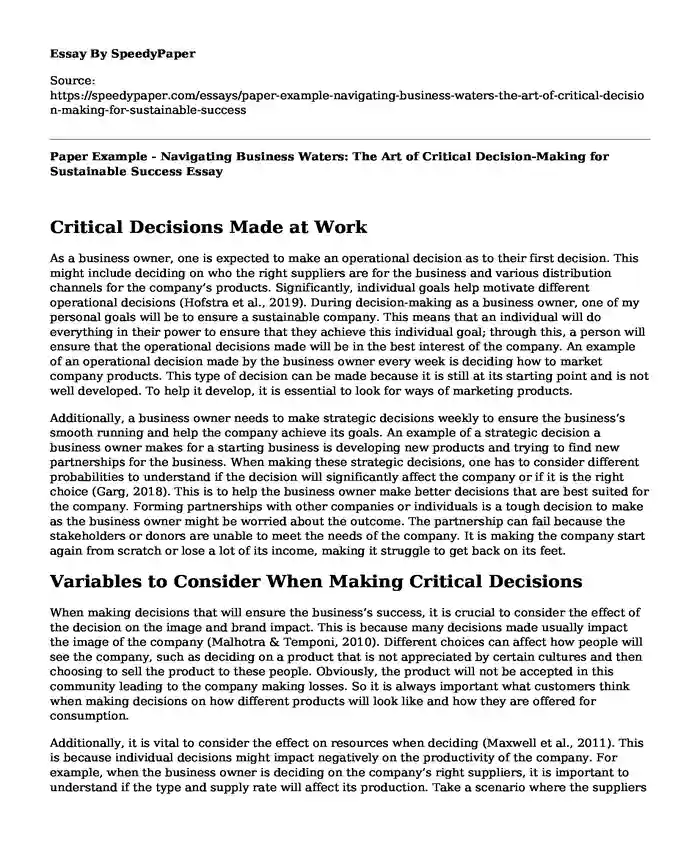Critical Decisions Made at Work
As a business owner, one is expected to make an operational decision as to their first decision. This might include deciding on who the right suppliers are for the business and various distribution channels for the company’s products. Significantly, individual goals help motivate different operational decisions (Hofstra et al., 2019). During decision-making as a business owner, one of my personal goals will be to ensure a sustainable company. This means that an individual will do everything in their power to ensure that they achieve this individual goal; through this, a person will ensure that the operational decisions made will be in the best interest of the company. An example of an operational decision made by the business owner every week is deciding how to market company products. This type of decision can be made because it is still at its starting point and is not well developed. To help it develop, it is essential to look for ways of marketing products.
Additionally, a business owner needs to make strategic decisions weekly to ensure the business’s smooth running and help the company achieve its goals. An example of a strategic decision a business owner makes for a starting business is developing new products and trying to find new partnerships for the business. When making these strategic decisions, one has to consider different probabilities to understand if the decision will significantly affect the company or if it is the right choice (Garg, 2018). This is to help the business owner make better decisions that are best suited for the company. Forming partnerships with other companies or individuals is a tough decision to make as the business owner might be worried about the outcome. The partnership can fail because the stakeholders or donors are unable to meet the needs of the company. It is making the company start again from scratch or lose a lot of its income, making it struggle to get back on its feet.
Variables to Consider When Making Critical Decisions
When making decisions that will ensure the business’s success, it is crucial to consider the effect of the decision on the image and brand impact. This is because many decisions made usually impact the image of the company (Malhotra & Temponi, 2010). Different choices can affect how people will see the company, such as deciding on a product that is not appreciated by certain cultures and then choosing to sell the product to these people. Obviously, the product will not be accepted in this community leading to the company making losses. So it is always important what customers think when making decisions on how different products will look like and how they are offered for consumption.
Additionally, it is vital to consider the effect on resources when deciding (Maxwell et al., 2011). This is because individual decisions might impact negatively on the productivity of the company. For example, when the business owner is deciding on the company’s right suppliers, it is important to understand if the type and supply rate will affect its production. Take a scenario where the suppliers for the company give their supplies at a slower pace. After a long time, it will force the company to start making some of these products or inform clients that the products are unavailable, leading to heavy losses.
Risks When Critical Decisions are Made Incorrectly or Late
When a decision is made incorrectly or late, the first risk is that the company might lose a lot of clients. This is likely to happen when a business owner makes a wrong operational decision, for instance, who will be the supplier of a given product. This is likely because clients will understand that the company does not care for them, so it lacks certain products or has the wrong products. Additionally, when wrong strategic decisions are incorrectly made or late, it can lead to the company failing to get new partnerships that could sponsor its activities hence ensuring its development.
References
Garg, H. (2018). Some methods for strategic decisionmaking problems with immediate probabilities in Pythagorean fuzzy environment. International Journal of Intelligent Systems, 33(4), 687-712. https://onlinelibrary.wiley.com/doi/abs/10.1002/int.21949.
Hofstra, N., Dullaert, W., De Leeuw, S., & Spiliotopoulou, E. (2019). Individual goals and social preferences in operational decisions: Behavioural insights from transport planning. International Journal of Operations & Production Management. https://www.emerald.com/insight/content/doi/10.1108/IJOPM-11-2016-0690/full/html.
Malhotra, R., & Temponi, C. (2009, September 11). Critical decisions for ERP integration: Small business issues. International Journal of Information Management. https://www.sciencedirect.com/science/article/pii/S0268401209000280.
Maxwell, A. L., Jeffrey, S. A., & Lévesque, M. (2009, October 13). Business angel early-stage decision making. Journal of Business Venturing. https://www.sciencedirect.com/science/article/pii/S0883902609000974.
Cite this page
Paper Example - Navigating Business Waters: The Art of Critical Decision-Making for Sustainable Success. (2024, Jan 25). Retrieved from https://speedypaper.com/essays/paper-example-navigating-business-waters-the-art-of-critical-decision-making-for-sustainable-success
Request Removal
If you are the original author of this essay and no longer wish to have it published on the SpeedyPaper website, please click below to request its removal:
- Defamiliarization - Art Essay Example
- Brand Equity Market Research. Free Essay.
- Time and Motion in Arts Essay Example
- Essay Example: Psychological and Sociological Influences on Dress
- Market Audit and Competitive Market Analysis of Tesla in Puerto Rico, Free Essay in Marketing
- Ethics and Professionalism Essay Sample
- Essay Example - Medical Coding II
Popular categories





